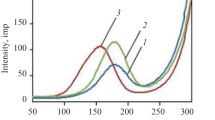Abstract
The minimum detectable dose (MDD) limit was examined in four different ways for groups of LiF:Mg,Ti thermoluminescent dosimeters, and two ways for CaF2:Dy, CaF2:Tm, CaF2:Mn, and CaSO4:Dy dosimeters. All types were irradiated and read out at dose intervals from 8.8 μGy to 6.6 mGy. Dose response linearity was never lost even for the lowest dose tested. As an ideal MDD, the signal arising from a zero applied dose readout was compared to calibration from true doses, resulting in signal corresponding to 0.04–0.1 μGy. The effects of fading and high ambient radon exposure on the MDD were examined.





Similar content being viewed by others
References
Piesch E, Burgkhardt B (1984) Environmental monitoring, European interlaboratory test programme for integrating dosemeter systems. Commission of the European Communities, Luxemburg (EUR 8932)
Ranogajec-Komor M (2009) In: Aycik GA (ed) New techniques for the detection of nuclear and radioactive agents. Springer, Dordrecht, pp 97–111
Ranogajec-Komor M, Knežević Ž, Miljanić S, Vekić B (2008) Characterisation of radiophotoluminescent dosimeters for environmental monitoring. Radiat Meas 43:392–396
International Electrotechnical Commission (2006) Thermoluminescence dosimetry systems for personal and environmental monitoring. IEC, Geneva (61066:1991)
International Electrotechnical Commission (2012) Radiation protection instrumentation—passive integrating dosimetry systems for environmental and personal monitoring. IEC, Geneva (EC 62387-1:2012)
Currie LA (1968) Limits for qualitative detection and quantitative determination: application to radiochemistry. Anal Chem 40:586–593
Hirning CR (1992) Detection and determination limits for thermoluminescence dosimetry. Health Phys 62:223–227
Knoll GF (2010) Radiation detection and measurement. Wiley, New York, pp 733–778
Busuoli G (1981) In: Oberhofer M, Scharmann A (eds) Applied thermoluminescence dosimetry. CRC Press, Bristol, pp 83–96
Traino AC, Perrone F, Luperini C, Tana L, Lazzeri M, d’Errico F (1998) Influence of background exposure on TLD minimum dose detection and determination limits. Radiat Prot Dosim 78:257–262
Harvey JA, Haverland NP, Kearfott KJ (2010) Characterization of the glow-peak fading properties of six common thermoluminescent materials. Appl Radiat Isot 68:1988–2000
Harvey JA, Kearfott KJ (2011) Reproducibility of glow peak fading characteristics of thermoluminescent dosimeters. Radiat Meas 46:319–322
Harvey JA, Kearfott KJ (2012) Effects of high ambient temperature on glow-peak fading properties of LiF:Mg,Ti thermoluminescent dosemeters. Radiat Prot Dosim 149:109–115
Weinstein M, German U, Dubinsky S, Alfassi ZB (2003) On the determination of the postirradiation time from the glow curve of TLD100. Radiat Prot Dosim 106:121–130
Studenski MT, Haverland NP, Kearfott KJ (2007) Simulation, design, and construction of a 137Cs irradiation facility. Health Phys 92:S78–S86
Parker LW, Harvey JA, Kearfott KJ (2011) An integrated system for the beta, gamma and neutron calibration and storage of thermoluminescent dosimeters for a research laboratory. Health Phys 100:S43–S49
Harvey JA, Thomas EM, Kearfott KJ (2011) Quantification of various factors influencing the precision of thermoluminescent detector calibrations for new and used chip sets. Health Phys 100:S79–S91
Simpkins RW, Kearfott KJ (1997) The minimum number of observations necessary to develop an average thermoluminescent dosimeter element correction factor. Radiat Prot Manag 13:55–61
McKeever SWS, Moscovitch M, Townsend PD (1995) Thermoluminescence dosimetry materials: properties and uses. Ramtrans Publishing, Ashford
Harvey JA, Rodrigues ML, Kearfott KJ (2011) A computerized glow curve analysis (GCA) method for WinREMS thermoluminescent dosimeter data using MATLAB. Appl Radiat Isot 69:1282–1286
Harvey JA, Kearfott KJ (2011) The effects of high ambient radon on thermoluminescence dosimetry readings. Radiat Prot Dosim 147:491–497
Bos AJJ, Piters TM, Gomez Ros JM, Delgado A (1994) An intercomparison of glow curve analysis computer programs: II. Measured glow curves. Radiat Prot Dosim 51:257–264
United States Environmental Protection Agency (2012) A citizen’s guide to radon. EPA 402/K-12/002. United States Environmental Protection Agency, Washington
Kearfott KJ (1989) Preliminary experiences with Rn222 in Arizona homes. Health Phys 56:169–179
Acknowledgments
Muhammad Rafique is grateful to the Higher Education Commission of Pakistan for providing his postdoctoral fellowship through Grant No. Ref: 2-6(22)/PDFP/HEC/2013/14.
Author information
Authors and Affiliations
Corresponding author
Rights and permissions
About this article
Cite this article
Harvey, J.A., Kearfott, K.J. & Rafique, M. Dose response linearity and practical factors influencing minimum detectable dose for various thermoluminescent detector types. J Radioanal Nucl Chem 303, 1711–1718 (2015). https://doi.org/10.1007/s10967-014-3794-6
Received:
Published:
Issue Date:
DOI: https://doi.org/10.1007/s10967-014-3794-6




